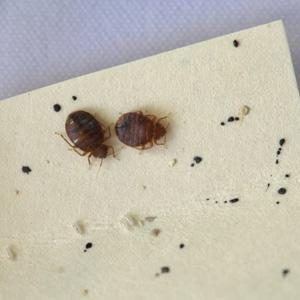A very old wish for a good night’s rest is “Sleep tight, and don’t let the bedbugs bite.” This is testimony to the fact that bed bug bites can disturb sleep, robbing a person of needed rest. Bed bugs have been recorded in ancient history, being mentioned as early as 400 BC. The historical accounts of these insects indicates their spread from the Mediterranean region to northern Europe, then to North America. Our word “bug” is derived from bugge, the original English name for these creatures.
The bed bug (Cimex lectularius) is a small, oval, flat wingless insect. Its only food is blood. The bedbug has mouth parts designed to pierce the skin of a host, inject an anti-coagulant with a painkiller, and suck the blood. A bed-bug can survive as long as half-a-year on one meal. These small parasites–an adult is only 5mm long–can hide in almost any crack or crevasse.
Bed bugs are so called because they are usually found in and around beds and mattresses. They can slip through the seams of mattress covers, hide in a box spring, or seclude themselves in the frames and upholstery of other furniture, or behind baseboards. Their small size and avoidance of light makes them hard to see, but signs of their presence can be found: feces, molted skins, stains from crushed bugs, etc., even odor.
The most personal sign of bed bugs is their bite. When a bedbug bites, a pain killer is injected along with the anti-coagulant. This anesthetic keeps the victim numbed long enough for the bug to finish its meal. But later, the bite site begins to itch. It may swell and become fevered. If scratched or rubbed, it can become infected. It is the irritation of the bite which disturbs sleepers, causing restlessness.
From the time they hatch until they die, bedbugs are bloodsuckers. The chart above shows their average sizes from the egg to adult from less than 1 mm as a newly hatched nymph to the 5 mm long adult.
Bed bugs had become almost unheard of in North America and Western Europe, but now they have made a comeback. A few years ago, these pests were being found in many high-class hotels. This has been blamed on travelers going to and from areas of the world where bed bugs and other parasites are common. Due to their minute size and secretive habits, they hitchike unnoticed in luggage.

Because they hide so well, bed bugs are hard to combat. Complicating this is the fact that many of them have become resistant to insecticides. The only sure way to eliminate bedbugs in a room is to heat it to about 130° F long enough to kill them. This is a job better left to experts who know how to do it safely.
The most effective way to prevent bed bug bites is to keep the little critters from getting to you. As noted in a previous Beds Blog article, mattress encasement serves this purpose two ways. First, bedbugs cannot get into a properly encased mattress. Secondly, if a bed bug happens to already be in a mattress, encasement will keep it from biting you.
All the seams in an effective mattress encasement will be sealed to close this avenue. And the zipper must have not gaps in the teeth big enough for a bed-bug, with the zipper kept tightly closed at the end. Some manufacturers of encasements have a special bug-proof zipper for this purpose.
Some mattresses are made with bedbug-proof seams, such as Naturepedic Baby and the Vinyl mattress by Paramount Mattress.
The most effective means of prevention is to deny the bed-bugs a place to hide or to prevent them from getting up to the bed. This means reducung or eliminating clutter. Other measures are keeping bedding from touching the floor and drying bedding and nightclothes with heat to kill any bugs which may be there, and thoroughly cleaning luggage when returning from a trip. A couple of generations ago, some people placed the feet of their beds in cans or pans of kerosene and kept the bed away from the wall. This worked because bed bugs cannot fly or jump.
Bed bugs have not been found to transmit disease-causing organisms from one human to another, even though they ingest pathogens with a host’s blood. The apparent reason for this is that, unlike mosquitoes, bed-bugs do not insert any of a previous host’s blood when they inject the anti-coalgulant. However, there is the opportunity for infection to enter the wound. Also, some persons may be allergic to bedbugs with the potential for a serious reaction, especially if they are already allergic to other insect bites and stings.
Although the potential for infectious diseases from bed bugs may be very low, sleep disturbance and lack of rest can be a hinderance to good health. We all need a good night’s rest, and one way is to not let the bed bugs bite.
Bed Bug Central: http://www.bedbugcentral.com/bedbugs101/mattress-and-box-spring-encasements
EPA: http://www2.epa.gov/bedbugs
The Straight Dope: http://www.straightdope.com/columns/read/1570/whats-the-origin-of-the-expression-sleep-tight
Wikipedia: http://en.wikipedia.org/wiki/Bed_bug
MedicineNet: http://www.medicinenet.com/bed_bugs/article.htm
Sleep Train: http://www.sleeptrain.com/education-bed-bugs.html
Beds Blog: https://beds.org/blog/mattresses-beds-and-how-we-sleep/
This entry was posted on Wednesday, March 4th, 2015 at 10:15 PM and is filed under beds, box springs, furniture, mattress covers, mattresses . You can follow any responses to this entry through the RSS 2.0 feed. You can leave a response, or trackback from your own site.

Get New Post Notification via Email:

One thought on ““Don’t Let the Bedbugs Bite””